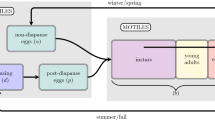Abstract
In many stage-structured species, different life stages often occupy separate spatial niches in a heterogeneous environment. Life stages of the giant flour beetle Tribolium brevicornis (Leconte), in particular adults and pupae, occupy different locations in a homogeneous habitat. This unique spatial pattern does not occur in the well-studied stored grain pests T. castaneum (Herbst) and T. confusum (Duval). We propose density dependent dispersal as a causal mechanism for this spatial pattern. We model and explore the spatial dynamics of T. brevicornis with a set of four density dependent integrodifference and difference equations. The spatial model exhibits multiple attractors: a spatially uniform attractor and a patchy attractor with pupae and adults spatially separated. The model attractors are consistent with experimental observations.
Similar content being viewed by others
References
Benoit, H. P., et al. (1998). Testing the demographic consequences of cannibalism in Tribolium confusum. Ecology, 78, 2839–2851.
Costantino, R. F., & Desharnais, R. A. (1991). Population dynamics and the Tribolium model: genetics and demography. New York: Springer.
Cushing, J. M. (2004). The LPA model. Fields Inst. Commun., 42, 29–55.
Cushing, J. M., et al. (2003). Chaos in Ecology: Experimental Nonlinear Dynamics, vol. 1. Theoretical Ecology Series. New York: Academic Press.
Dennis, B., et al. (1995). Nonlinear demographic dynamics: Mathematical models, statistical methods, and biological experiments. Ecol. Monogr., 65, 261–281.
Edmunds, J., et al. (2003). Park’s Tribolium competition experiments: a non-equilibrium species coexistence hypothesis. J. Anim. Ecol., 72, 703–712.
Ghent, A. W. (1966). Studies of behavior of the Tribolium flour beetles. II. Distributions in depth of T. castaneum and T. confusum in fractionable shell vials. Ecology, 47, 355–367.
Harrison, R. G. (1980). Dispersal polymorphisms in insects. Ann. Rev. Ecolog. Syst., 11, 95–118.
Hastings, A., & Costantino, R. F. (1991). Oscillations in population numbers: age-dependent cannibalism. J. Anim. Ecol., 60, 471–482.
Hill, C. (1988). Life cycle and spatial distribution of the amphipod Pallasea quadrispinosa in a lake in northern Sweden. Holartic Ecology, 11, 298–304.
Hunte, W., & Myers, R. A. (1984). Phototaxis and cannibalism in gammaridean amphipods. Mar. Biol., 81, 75–79.
Jillson, D. A., & Costantino, R. F. (1980). Growth, distribution, and competition of Tribolium castaneum and Tribolium brevicornis in fine-grained habitats. Am. Nat., 116, 206–219.
Jormalainen, V., & Shuster, S. M. (1997). Microhabitat segregation and cannibalism in an endangered freshwater isopod, Thermosphaeroma thermophilum. Oecologia, 111, 271–279.
Kisimoto, R. (1956). Effect of crowding during the larval period on the determination of the wing form of an adult plant-hopper. Nature, 178, 641–642.
Leonardsson, K. (1991). Effects of cannibalism and alternative prey on population dynamics of Saduria entomon (Isopoda). Ecology, 72, 1273–1285.
Leslie, P. H., Park, T., & Mertz, D. B. (1968). The effect of varying the initial numbers on the outcome of competition between two Tribolium species. J. Anim. Ecol., 37, 9–23.
Ribes, M., et al. (1996). Small scale spatial heterogeneity and seasonal variation in a population of a cave-dwelling Mediterannean mysid. J. Plankton Res., 18, 659–671.
Robertson, S. L. (2009) Spatial patterns in stage-structured populations with density dependent dispersal, PhD Thesis, University of Arizona.
Robertson, S. L., & Cushing, J. M. (2011a). Spatial segregation in stage-structured populations with an application to Tribolium. Journal of Biological Dynamics, 5(5), 398–409.
Robertson, S. L., & Cushing, J. M. (2011b). A bifurcation analysis of stage-structured density dependent integrodifference equations. J. Math. Anal. Appl. doi:10.1016/j.jmaa.2011.09.064.
Sokoloff, A., et al. (1980). Observations on populations of Tribolium brevicornis (Le conte) (Coleoptera, Tenebrionidae). I. Laboratory observations of domesticated strains. Res. Popul. Ecol., 22, 1–12.
Author information
Authors and Affiliations
Corresponding author
Rights and permissions
About this article
Cite this article
Robertson, S.L., Cushing, J.M. & Costantino, R.F. Life Stages: Interactions and Spatial Patterns. Bull Math Biol 74, 491–508 (2012). https://doi.org/10.1007/s11538-011-9705-x
Received:
Accepted:
Published:
Issue Date:
DOI: https://doi.org/10.1007/s11538-011-9705-x




